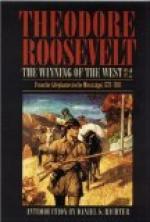As it was, there were still so few whites in Kentucky that they were greatly outnumbered by the invading Indians. They were, in consequence, unable to meet the enemy in the open field, and gathered in their stations or forted villages. Therefore the early conflicts, for the most part, took the form of sieges of these wooden forts. Such sieges, had little in common with the corresponding operations of civilized armies. The Indians usually tried to surprise a fort; if they failed, they occasionally tried to carry it by open assault, or by setting fire to it, but very rarely, indeed, beleaguered it in form. For this they lacked both the discipline and the commissariat. Accordingly, if their first rush miscarried, they usually dispersed in the woods to hunt, or look for small parties of whites; always, however, leaving some of their number to hover round the fort and watch any thing that took place. Masters in the art of hiding, and able to conceal themselves behind a bush, a stone, or a tuft of weeds, they skulked round the gate before dawn, to shoot the white sentinels; or they ambushed the springs, and killed those who came for water; they slaughtered all of the cattle that had not been driven in, and any one venturing incautiously beyond the walls was certain to be waylaid and murdered. Those who were thus hemmed in the fort were obliged to get game on which to live; the hunters accordingly were accustomed to leave before daybreak, travel eight or ten miles, hunt all day at the risk of their lives, and return after dark. Being of course the picked men of the garrison, they often eluded the Indians, or slew them if an encounter took place, but very frequently indeed they were themselves slain. The Indians always trusted greatly to wiles and feints to draw their foes into their power. As ever in this woodland fighting, their superiority in hiding, or taking advantage of cover, counterbalanced the superiority of the whites as marksmen; and their war parties were thus at least a match, man against man, for the Kentuckians, though the latter, together with the Watauga men, were the best woodsmen and fighters of the frontier. Only a very few of the whites became, like Boon and Kenton, able to beat the best of the savages at their own game.
The innumerable sieges that took place during the long years of Indian warfare differed in detail, but generally closely resembled one another as regards the main points. Those that occurred in 1777 may be considered as samples of the rest; and accounts of these have been preserved by the two chief actors, Boon and Clark. [Footnote: In Boon’s narrative, written down by Filson, and in Clark’s diary, as given by Morehead. The McAfee MSS. and Butler’s history give some valuable information. Boon asserts that at this time the “Long Knives” proved themselves superior to their foe in almost every battle; but the facts do not seem to sustain him, though the statement was doubtless true as regards a few picked men. His estimates of the Indian numbers and losses must be received with great caution.]




